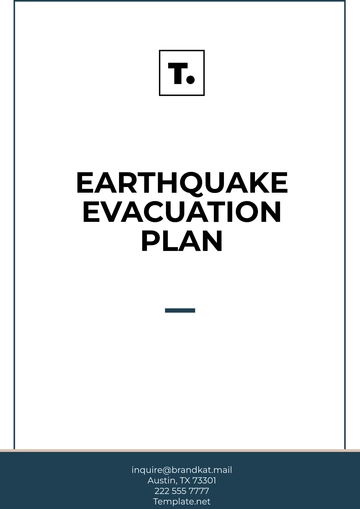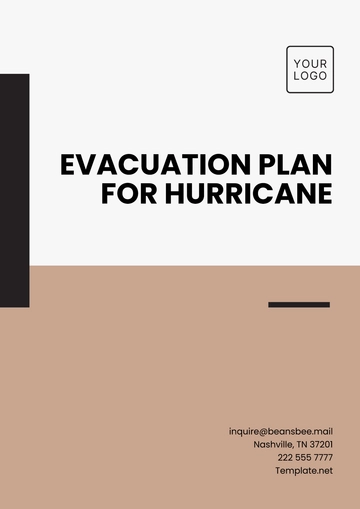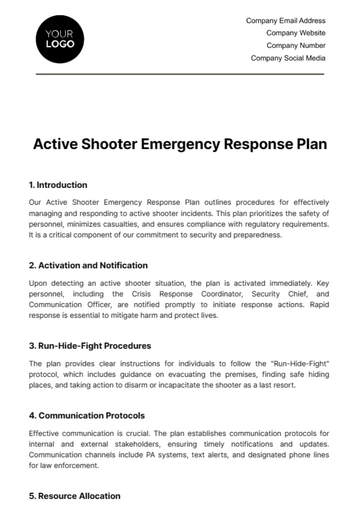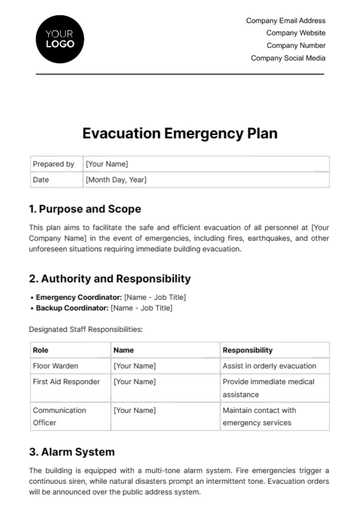Free Active Shooter Emergency Response Plan
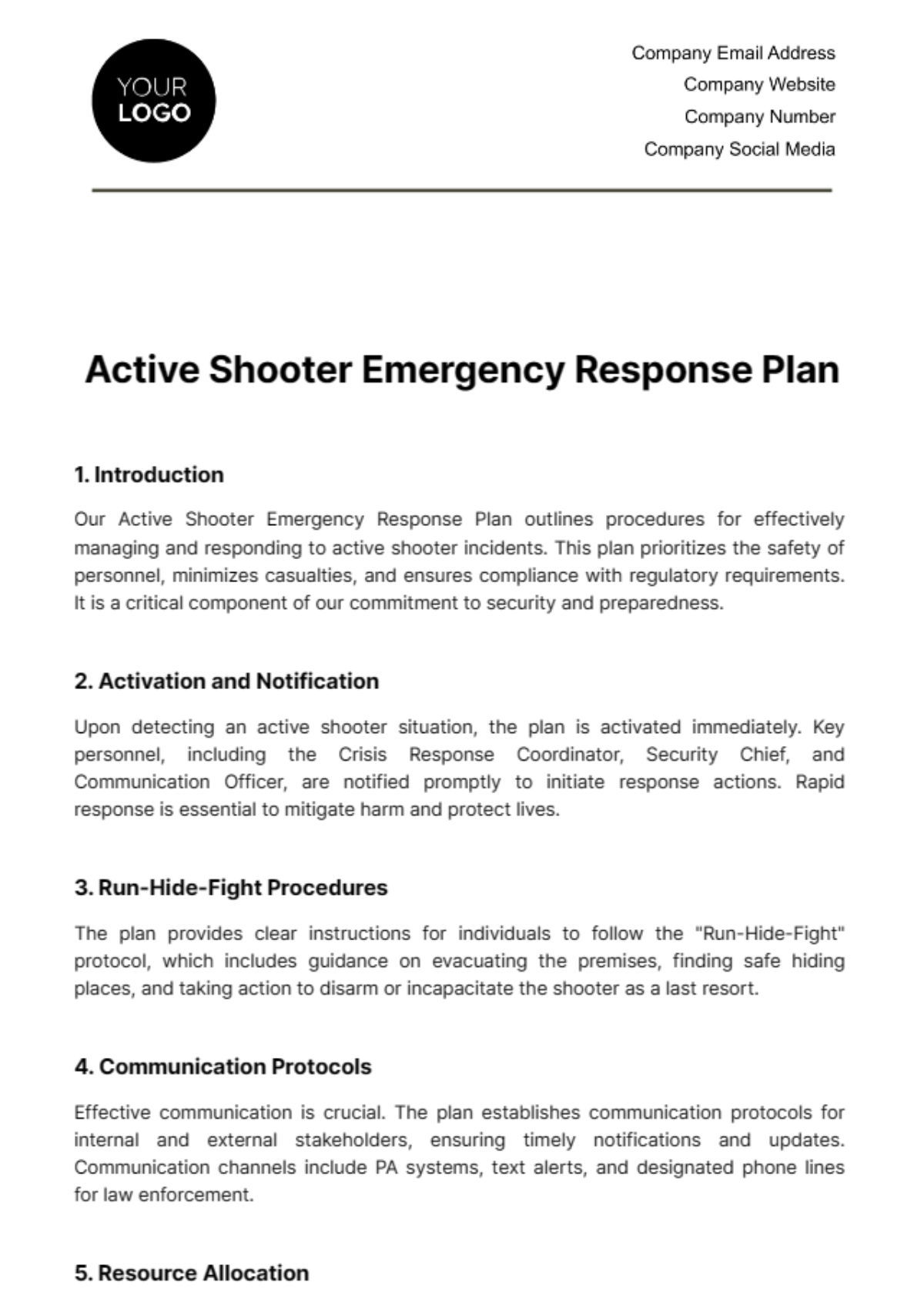
1. Introduction
Our Active Shooter Emergency Response Plan outlines procedures for effectively managing and responding to active shooter incidents. This plan prioritizes the safety of personnel, minimizes casualties, and ensures compliance with regulatory requirements. It is a critical component of our commitment to security and preparedness.
2. Activation and Notification
Upon detecting an active shooter situation, the plan is activated immediately. Key personnel, including the Crisis Response Coordinator, Security Chief, and Communication Officer, are notified promptly to initiate response actions. Rapid response is essential to mitigate harm and protect lives.
3. Run-Hide-Fight Procedures
The plan provides clear instructions for individuals to follow the "Run-Hide-Fight" protocol, which includes guidance on evacuating the premises, finding safe hiding places, and taking action to disarm or incapacitate the shooter as a last resort.
4. Communication Protocols
Effective communication is crucial. The plan establishes communication protocols for internal and external stakeholders, ensuring timely notifications and updates. Communication channels include PA systems, text alerts, and designated phone lines for law enforcement.
5. Resource Allocation
Resource allocation involves deploying personnel, security teams, and first responders to handle the situation. The plan maintains records of resource allocation, including personnel assignments and equipment deployment, to ensure a coordinated response.
Table: Resource Allocation
Resource Type | Allocation Details | Responsible Personnel |
Security Personnel | Deployment to critical areas | Security Chief |
First Responders | Immediate response and assistance | Crisis Response Coordinator |
Medical Teams | Medical assistance and triage | Medical Director |
6. Training and Drills
Regular training and drills are conducted to ensure that response teams and all personnel are prepared to handle active shooter incidents safely and effectively. Training covers response procedures, evacuation routes, and communication protocols. Drills provide practical experience for personnel.
7. Evaluation and Improvement
After each active shooter incident response, an evaluation is conducted to identify areas for improvement. Lessons learned are documented and used to enhance response procedures continually. This process ensures that our response capabilities evolve and become more effective.
8. Conclusion
Our Active Shooter Emergency Response Plan underscores our unwavering commitment to the safety and security of our personnel and facilities. It provides the structure and guidance needed to respond to active shooter incidents with precision, protecting lives and assets while maintaining compliance with regulations.
Health & Safety Templates @ Template.net
- 100% Customizable, free editor
- Access 1 Million+ Templates, photo’s & graphics
- Download or share as a template
- Click and replace photos, graphics, text, backgrounds
- Resize, crop, AI write & more
- Access advanced editor
Stay prepared for active shooter incidents with Template.net's Active Shooter Emergency Response Plan Template. This editable and customizable tool offers a comprehensive framework for swift action. Easily tailor procedures to your organization's needs with our Ai Editor Tool. Trust Template.net for effective solutions in emergency preparedness.
You may also like
- Finance Plan
- Construction Plan
- Sales Plan
- Development Plan
- Career Plan
- Budget Plan
- HR Plan
- Education Plan
- Transition Plan
- Work Plan
- Training Plan
- Communication Plan
- Operation Plan
- Health And Safety Plan
- Strategy Plan
- Professional Development Plan
- Advertising Plan
- Risk Management Plan
- Restaurant Plan
- School Plan
- Nursing Home Patient Care Plan
- Nursing Care Plan
- Plan Event
- Startup Plan
- Social Media Plan
- Staffing Plan
- Annual Plan
- Content Plan
- Payment Plan
- Implementation Plan
- Hotel Plan
- Workout Plan
- Accounting Plan
- Campaign Plan
- Essay Plan
- 30 60 90 Day Plan
- Research Plan
- Recruitment Plan
- 90 Day Plan
- Quarterly Plan
- Emergency Plan
- 5 Year Plan
- Gym Plan
- Personal Plan
- IT and Software Plan
- Treatment Plan
- Real Estate Plan
- Law Firm Plan
- Healthcare Plan
- Improvement Plan
- Media Plan
- 5 Year Business Plan
- Learning Plan
- Marketing Campaign Plan
- Travel Agency Plan
- Cleaning Services Plan
- Interior Design Plan
- Performance Plan
- PR Plan
- Birth Plan
- Life Plan
- SEO Plan
- Disaster Recovery Plan
- Continuity Plan
- Launch Plan
- Legal Plan
- Behavior Plan
- Performance Improvement Plan
- Salon Plan
- Security Plan
- Security Management Plan
- Employee Development Plan
- Quality Plan
- Service Improvement Plan
- Growth Plan
- Incident Response Plan
- Basketball Plan
- Emergency Action Plan
- Product Launch Plan
- Spa Plan
- Employee Training Plan
- Data Analysis Plan
- Employee Action Plan
- Territory Plan
- Audit Plan
- Classroom Plan
- Activity Plan
- Parenting Plan
- Care Plan
- Project Execution Plan
- Exercise Plan
- Internship Plan
- Software Development Plan
- Continuous Improvement Plan
- Leave Plan
- 90 Day Sales Plan
- Advertising Agency Plan
- Employee Transition Plan
- Smart Action Plan
- Workplace Safety Plan
- Behavior Change Plan
- Contingency Plan
- Continuity of Operations Plan
- Health Plan
- Quality Control Plan
- Self Plan
- Sports Development Plan
- Change Management Plan
- Ecommerce Plan
- Personal Financial Plan
- Process Improvement Plan
- 30-60-90 Day Sales Plan
- Crisis Management Plan
- Engagement Plan
- Execution Plan
- Pandemic Plan
- Quality Assurance Plan
- Service Continuity Plan
- Agile Project Plan
- Fundraising Plan
- Job Transition Plan
- Asset Maintenance Plan
- Maintenance Plan
- Software Test Plan
- Staff Training and Development Plan
- 3 Year Plan
- Brand Activation Plan
- Release Plan
- Resource Plan
- Risk Mitigation Plan
- Teacher Plan
- 30 60 90 Day Plan for New Manager
- Food Safety Plan
- Food Truck Plan
- Hiring Plan
- Quality Management Plan
- Wellness Plan
- Behavior Intervention Plan
- Bonus Plan
- Investment Plan
- Maternity Leave Plan
- Pandemic Response Plan
- Succession Planning
- Coaching Plan
- Configuration Management Plan
- Remote Work Plan
- Self Care Plan
- Teaching Plan
- 100-Day Plan
- HACCP Plan
- Student Plan
- Sustainability Plan
- 30 60 90 Day Plan for Interview
- Access Plan
- Site Specific Safety Plan
